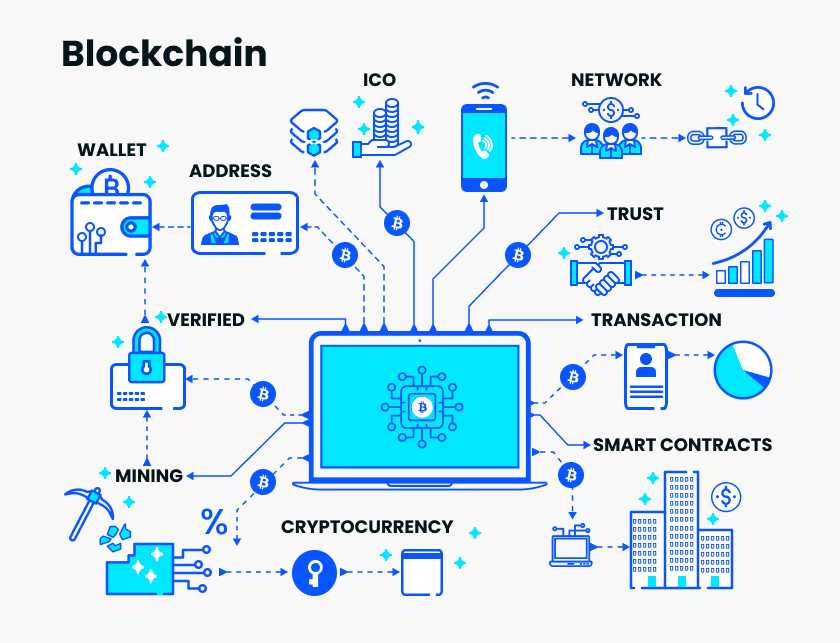Blockchain: Paving the Way for a Decentralized Future

Introduction
In a world seeking transparency, security, and trust in digital transactions, blockchain has emerged as a revolutionary technology with far-reaching implications. Born as the underlying technology for cryptocurrencies like Bitcoin, blockchain has evolved into a versatile and transformative force, transcending its origins. In this blog, we will explore the fascinating world of blockchain, its fundamental concepts, diverse applications, and the potential it holds for reshaping industries and society as a whole.
Understanding Blockchain
At its core, blockchain is a decentralized and distributed ledger that records transactions across a network of computers in a secure and immutable manner. Unlike traditional centralized systems, blockchain does not rely on a single authority but operates through consensus among participants. Each transaction, or "block," is linked to the previous one, forming a chronological chain of blocks, hence the name "blockchain."
How Blockchain Works
The three essential components of blockchain are:
Decentralization: Instead of relying on a central authority, blockchain operates on a peer-to-peer network, where each participant (node) stores a copy of the entire ledger.
Consensus Mechanism: To validate and agree on the accuracy of transactions, blockchain networks utilize consensus mechanisms such as Proof of Work (PoW) or Proof of Stake (PoS), among others.
Cryptographic Security: Each block is cryptographically linked to the previous one, making it practically impossible to alter or tamper with the data stored in the blockchain.
Applications of Blockchain
Beyond its association with cryptocurrencies, blockchain's potential reaches into various domains:
1. Supply Chain Management: Blockchain can enhance supply chain transparency, tracking the origin and movement of goods, reducing fraud, and ensuring ethical sourcing.
2. Financial Services: Blockchain disrupts traditional financial systems by enabling faster and cheaper cross-border payments, remittances, and enabling smart contracts for automated transactions.
3. Healthcare: In healthcare, blockchain ensures secure and interoperable medical records, simplifying data exchange among healthcare providers and improving patient outcomes.
4. Voting Systems: Blockchain-based voting systems offer transparency and security, reducing the likelihood of electoral fraud.
5. Intellectual Property: Blockchain can protect intellectual property rights, offering artists and creators a transparent and immutable record of their work.
Advantages of Blockchain
The adoption of blockchain brings several benefits:
Transparency: Blockchain's transparent nature allows participants to track transactions and data in real-time, promoting accountability.
Security: Blockchain's cryptographic properties ensure data integrity and protection against unauthorized access or modification.
Cost Efficiency: By eliminating intermediaries and streamlining processes, blockchain reduces transaction costs and operational inefficiencies.
Trust and Immutability: Once data is recorded on the blockchain, it cannot be altered or deleted, fostering trust among participants.
Challenges and Future Considerations
While blockchain holds tremendous potential, it faces several challenges:
Scalability: As blockchain networks grow, scalability becomes a concern, as the technology must handle a higher volume of transactions without compromising speed and efficiency.
Regulatory Frameworks: The absence of standardized regulatory frameworks for blockchain presents challenges in its widespread adoption.
Energy Consumption: Certain consensus mechanisms, like Proof of Work, consume significant energy, prompting the need for more eco-friendly alternatives.
Conclusion
Blockchain technology stands at the forefront of a new era, offering solutions to age-old problems of trust, security, and transparency in digital interactions. As its potential becomes more evident, various industries are beginning to embrace the possibilities blockchain presents. Despite challenges, blockchain's decentralized architecture and immutable nature hold the promise of a more equitable and efficient future. As we navigate this ever-evolving landscape, responsible adoption and innovation will shape how blockchain transforms industries and society, unlocking opportunities that were once beyond our imagination.
Comments
Post a Comment